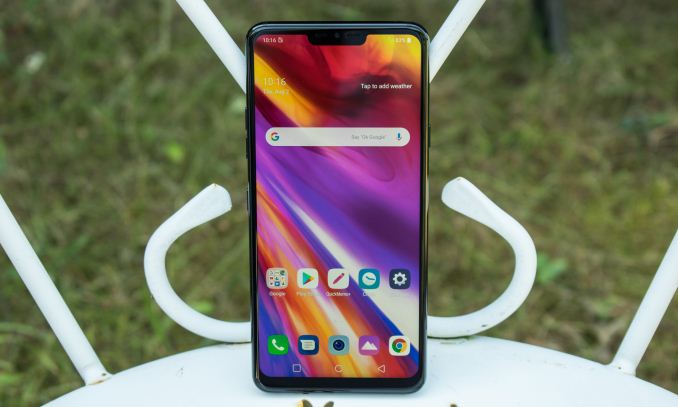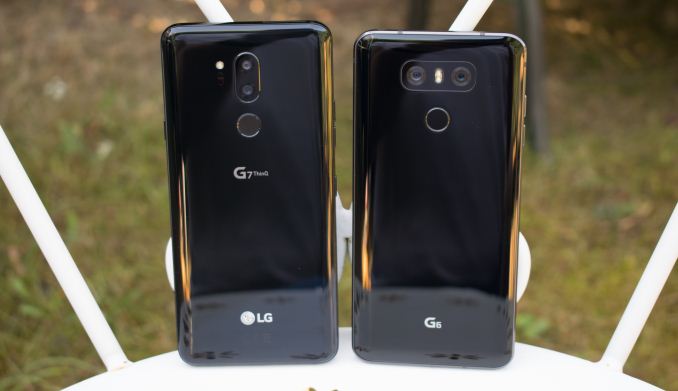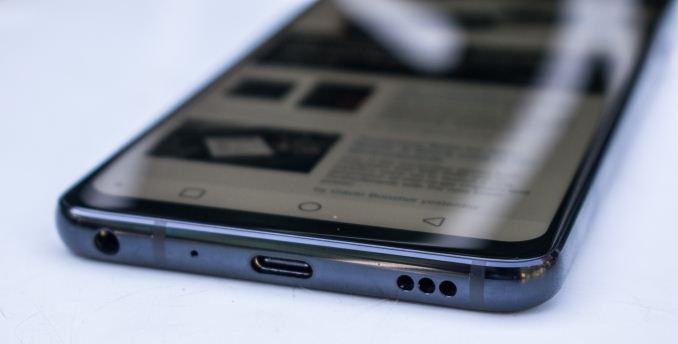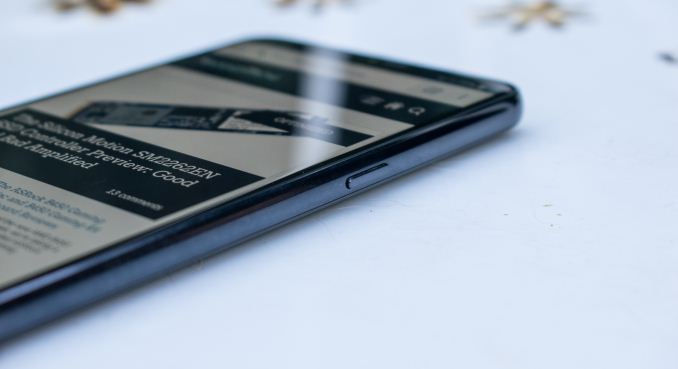The LG G7 Review: A Rushed Attempt?
by Andrei Frumusanu on August 9, 2018 11:00 AM EST- Posted in
- Smartphones
- LG
- Mobile
- LG G7 ThinQ
- LG G7

This year was a change in pace for LG. The company's "mainline" flagship device, the LG G7, was released a couple of months later later than in years prior, hitting the market in the early summer rather than the more traditional spring.
And while this may sound like a trivial distinction, it's actually more meaningful than it may first appear. The tight schedules in the smartphone industry mean that time is often the most valuable asset a manufacturer can have. In this case, scheduling the G7 for a bit later in the year gave LG an opportunity to try to raise its build-quality and to offer a well-rounded smartphone, in order to produce a more viable competitor to the fierce competition that are the other flagship handsets.
The biggest impact of this shift comes in the form of the SoC – the heart of the phone. Unlike last year's LG G6, where LG opted to use a prior generation SoC, for this year, the G7 avoids such a compromise. Instead LG is packing the phone with the latest internals, and at least on paper, it looks to be a competitive offering for 2018.
LG’s been in a relatively rough spot in the last couple of years, as we’ve seen the company stumble in terms of product execution. The LG G4 suffered from performance and battery issues due the Snapdragon 808/810 issues for that generation. The G5 promised great innovation through its modular design, however this again didn’t exactly pan out in terms of commercial success, mostly due to the phone’s weaknesses such as the display as well as a compromise in build quality due to the modular design.
The G6 overall was probably LG’s most solid phone over the last few years and it didn’t have any deal-breaking issues, other than it being a S821 device in a year of S835 alternatives. 2017 has been probably the year where the V-series actually seemingly has outshined the G-series as LG’s top-tier flagship line.
The V30 has been an excellent device, however I’ve been abstaining recommendations of phone due to the fact that my review unit had really bad uniformity issues, as well as bad low-brightness picture quality on the display. Newer units we've been sampled have offered better uniformity, but both were still not quite as perfect as you'd find from Samsung alternatives. Least to say, having to play the display lottery is not something that should be happening at these price-points.
The G7 promises a lot in terms of specifications, but most importantly for LG, what the phone needs to deliver is an increase in the overall product quality as well as more attention to detail.
| LG ThinQ G7 | ||
| LG G7 | LG G6 | |
| SoC | Qualcomm Snapdragon 845 4x Kryo 385 Performance @ 2.8GHz 4x Kryo 385 Efficiency @ 1.77GHz Adreno 630 @ 710MHz |
Qualcomm Snapdragon 820 2x Kryo @ 2.34GHz 2x Kryo @ 2.19GHz Adreno 530 @ 653MHz |
| Display | 6.09-inch 3120x1440 (19.5:9) IPS LCD |
5.7-inch 2880x1440 (18:9) IPS LCD |
| Dimensions | 153.2 x 71.9 x 7.9 mm 162 grams |
148.9 x 71.9 x 7.9 mm 163 grams |
| RAM | 4GB LPDDR4x | |
| NAND | 64GB UFS 2.1 + microSD |
32/64GB UFS + microSD |
| Battery | 3000 mAh (11.55 Wh) non-replaceable |
3300 mAh (12.54 Wh) non-replaceable |
| Front Camera | 8MP medium angle (90°) | 5MP, f/2.2, wide-angle (100°) |
| Primary Rear Camera | 16MP Sony IMX351 1/3.09" 1µm pixels, narrow angle (70°) F/1.6 lens w/OIS |
13MP, Sony IMX258, narrow angle (71°) 1.12µm pixels, F/1.8 lens w/OIS |
| Secondary Rear Camera | 16MP Sony IMX351 1/3.09" 1µm pixels, wide angle (107°) F/1.9 lens |
13MP, Sony IMX258, wide-angle (125°) 1.12µm pixels, F/2.4 lens |
| SIM Size | NanoSIM | |
| Wireless | 802.11a/b/g/n/ac 2x2 MU-MIMO, BT 5.0 LE, NFC, GPS/Glonass/Galileo/BDS |
|
| Connectivity | USB Type-C, 3.5mm headset | |
| Features | Fingerprint reader, display notch, high resonancy speaker, AI assistant button, IP68 rating |
Fingerprint reader |
| Launch OS | Android 8.0 | Android 7.1 with LG UX 6.0 |
In terms of the hardware, the G7 is a large upgrade over the G6 as it represents a two-generation jump in the SoC, switching from the Snapdragon 821 to a Snapdragon 845. Performance wise we should see excellent results from the G7, as most other Snapdragon 845 devices this year have just been fantastic products.
The phone comes with 4GB of main memory as well as 64GB of UFS 2.1 storage, with the option of a microSD slot for expandable storage.
In terms of device footprint, LG actually managed to match the width and thickness of the G6 – although the industrial design has changed. The new G7 ergonomically feels like a smaller phone thanks to its more rounded edges. Where the G7 differs from the G6 in terms of dimensions is the height: it adds 4.3mm on to the top of the phone. The new format houses a longer 19.5:9 aspect-ratio screen which comes with a top display notch. Although the device is longer, its top and bottom bezels have seen a reduction compared to the G6 so the overall display-to-body ratio has increased.
A non-visible change in terms of the internals is that the battery size has actually decreased from 3300mAh down to 3000mAh – it’s possible that LG had to do this to be able to integrate the new speaker design. Overall though this doesn’t concern me too much as the efficient SoC and promised screen efficiency should still result in good battery life.
The display saw a lot of fanfare as the 3120x1440 resolution unit is of a new RGBW "M+" subpixel layout technology which promises great strides in terms of display power and power efficiency.
The back of the phone we continue to see a glass cover, and it comes with all the usually associated advantages, such as wireless charging and an IP68 rating. The camera housing has seen a redesign as the horizontal dual-camera layout in the G6 and V30 has been replaced for a smaller and tighter vertical setup.
The G7’s camera hardware hasn’t changed much from the V30’s – the main camera is still a 1/3.09" 16MP Sony IMX351 with 1µm pixels and a lens with a large f/1.6 aperture.
The wide-angle module however has seen larger changes as it sees a resolution bump from though a sensor upgrade, this time around using the same sensor as the main camera. Also notable is that the wide-angle view has been reduced from 120° down to 107° - still offering a wide angle experience but reducing the fish-eye perspective and also improving image quality by reducing chromatic aberrations on the outer portions of the image.
LG jumps on the display notch bandwagon; the official name for the G7's notch is “new second screen”. In practical terms it doesn’t differ much from what we’ve seen with other vendors. LG also offers different options to customise the area – going from various more artistic background options to the option of just blacking out the notch. For an LCD screen the G7 actually really surprised me as the display offered sufficiently high contrast ratio that blacking out the notch worked basically *almost* well as an OLED screen – however it was still visible in some bright scenarios.
On the bottom of the phone we find the speaker grill with 3 large holes. LG has made big promises on the speaker improvements as it uses the whole internal space of the phone as a resonance chamber, promising louder and better audio. Objectively measuring this was one of the reasons I’ve (re)introduced speaker evaluation into recent reviews so we’ll later in the article how LG’s efforts panned out.
There’s a USB-C port, a microphone and a 3.5mm headphone jack. LG still caters to audiophile crowd and the G7 integrates a ESS Technology ES9218P audio SoC which is stated to be able to have enough capabilities and power to drive even the most demanding high-impedance headphones with up to a 2Vrms output voltage. I measured this and unfortunately the G7 doesn't quite reach the promised levels as it is only capable of 0.764Vrms without the Quad-DAC and 1.030Vrms with the Quad-DAC enabled. Distortion wise however the G7 performed excellently - I'm working on re-building a proper audio measurement methodology for the future.
On the right side of the phone we find a lone power button. LG’s past flagships had the power button integrated on the back on the fingerprint sensor, while this was “okey” in terms of ergonomics I still think a side-power button does a better job so LG going back to the more traditional placement is a good thing in my book. The SIM and SD card tray has been now relocated to the top of the phone.
On the left side we find the volume buttons, and a brand new assistant button. Instead of creating a new custom assistant, LG fully integrates Google Now. I found the button to have a massive usability issues in terms of actually listening to commands as there’s a notable delay between pressing the button and Google Now actually starting to listen to your queries. I found this annoying enough and such a bad integration that I think it kind of defeats the purpose of the button – for contrast and as an example, Samsung’s Bixby button will instantaneously start listening to a query as soon as you press the button and the app will catch up with responding.

















69 Comments
View All Comments
melgross - Friday, August 10, 2018 - link
Interestingbthatvwhile they include theciphones in a few benchmarks, they aren’t mentioned in the article even once.lucam - Thursday, August 9, 2018 - link
iPad Pro review anytime soon? Or You guys have given up on testing tablets?collegsd - Friday, July 5, 2019 - link
https://bit.ly/2Xt0XYc
https://bit.ly/32jw9bk
ados_cz - Friday, August 10, 2018 - link
I got new G6 week ago and was really disappointed with the jpeg processing and softness of the ultrawide angle module. Then someone noted that Google Pixel camera app was ported to other snapdragon devices and gets much better results. You can still see that it is not perfect if you pixel-peep, but I am in peace with it now when using the ported app.https://photos.app.goo.gl/d4K6LH4oazGmboBK6
abufrejoval - Saturday, August 11, 2018 - link
Must be quite a sight, seeing you walk around Luxemburg taking pictures with dozens of phones...Andrei Frumusanu - Saturday, August 11, 2018 - link
It's more of an issue of having enough pockets...chadhumm - Saturday, August 11, 2018 - link
One comment. I loved LG's but I had to return the LGG7 the worst phone Ive ever had in regards to reception. Makes all the bells and whistles worthless. This in many areas city and rural. Traded for the S9 it is much better but not as good as the Motorola z force that I was replacing. Too bad because I had good luck with the g2 and g3nikon133 - Sunday, August 12, 2018 - link
I'm reasonably happy with G7. Got it for my work phone as it is much cheaper than S9+ here in NZ... $1000 vs $1500.Camera is my only real disappointment - yes it does watercolor greenery. That said, I am a bit of a camera freak, and there is no camera phone that really satisfies me - whenever I plan to shoot, I will have at least RX100 on me, if not dSLR. This makes me dislike G7 camera even more - but, at the same time, it makes me not care much as well, since I usually don't depend on phone cameras. Down-sampled to ~2MP (1080p full screen), photos are usable. This is really where my phone cameras' expectations end, regardless of model.
Oddly, screen color hasn't really impacted me, albeit I have moved to this phone from Nexus 5X and Lumia 950 XL... both should have decent screens, if memory serves. Might be because I use phone under different light and ever-changing conditions are preventing me from really having an issue with screen accuracy. Screen readability is quite good, even under sun, and resolution is a pleasure. I am wearing glasses for distance and they don't work well up close, so I usually look at the phone screen over the glasses, and, in result, bring phone very close to my face... where resolution shows more than from "normal" reading distance.
Battery holds well in my scenario. Even at the begging when phone use was higher than average - downloading and trying apps, setting accounts, running initial updates etc., I was not draining more than 60% between morning and evening. Everyday use it is 30 - 40%. Basically I can do full 2 days, and with wireless chargers at my office desk and bedside, absolutely no problems here... that said, I don't play games on phone.
Overall? Happy, so far. I'm aware of compromises, but price difference more than justifies them, imho. I am also not a big fan of Samsung's curved screen - it does nook nice but it also does expose screen more, judging from my colleagues' experiences with S7 Edge and S8.
jvl - Sunday, August 12, 2018 - link
But...does it Loop Good®?!? Or will we have to wait until we find out?Great_Scott - Thursday, August 16, 2018 - link
What this review did better than anything else was convince me to get a OnePlus6. It has the best camera at mid/high light levels and the (very well done) LCD screen of the G7 is inefficient at the lowest light levels (which is where I set my phone the vast majority of the time). The smaller-sized battery isn't great either.